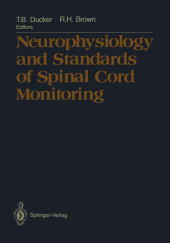 Neuerscheinungen 2012Stand: 2020-01-07 |
Schnellsuche
ISBN/Stichwort/Autor
|
Herderstraße 10
10625 Berlin
Tel.: 030 315 714 16
Fax 030 315 714 14
info@buchspektrum.de |

Richard H. Brown, Thomas B. Ducker
(Beteiligte)
Neurophysiology and Standards of Spinal Cord Monitoring
Herausgegeben von Ducker, Thomas B.; Brown, Richard H.
Softcover reprint of the original 1st ed. 1988. 2012. viii, 388 S. VIII, 388 pp. 245 figs. 254 mm
Verlag/Jahr: SPRINGER, BERLIN 2012
ISBN: 1-461-28359-0 (1461283590)
Neue ISBN: 978-1-461-28359-1 (9781461283591)
Preis und Lieferzeit: Bitte klicken
Standards.- Standardization of Evoked Potential Recording.- Clinical Neurophysiology of Neural Stimulation.- Ascending Recordings.- Human Spinal Cord Potentials (SCPs): Ascending Recording Variations - an Update.- Evaluation of Segmental Spinal Evoked Potentials with Topographic Computer Display and Dipole.- Intraspinal SEPs Recorded from the Vicinity of the Dorsal Root Entry Zone.- Interpretation of Anterior and Posterior Spinal SEPs During Scoliosis Surgery.- Experimental Ascending Evoked Potentials in Spinal Cord Injury.- Effects of Spinal Cord Compression on Repetitive Impulse Conduction of Ascending Fibers in the Dorsal Column.- The Effect of Chymopapain on Nerve Impulse Transmission in the Rat.- Diagnosis of Cervical Myelopathy Using Segmental Evoked Spinal Cord Potentials Obtained by Stimulating Finger Surface.- Descending Recordings.- Spinal Cord Potentials (SCPs) Produced by Descending Volleys in the Rat.- Intradural Spinal Recordings (Particular Reference to Invasive Methods).- Corticospinal Direct Response to Stimulation of the Exposed Motor Cortex in Humans.- Usefulness of Motor Evoked Potentials (Pyramidal D-Response) for Assessment of Spinal Cord Injury.- Spinal Cord Potentials (SCPs) Produced by Descending Volleys in Man.- Anesthesia Influence on Recordings.- Effects of Anesthetic Drugs on Spinal Cord Monitoring: An Update.- Sites, Rates and Filters that Best Eliminate Background Noise and Variability during Cortical Evoked Potentials in Spinal Cord Monitoring.- Effect of Isoflurane on Human Median Nerve Evoked Potentials.- Evoked Potential Monitoring of Anesthetic and Operative Manipulation.- Effects of Intravenous Anesthetic Induction Agents on Somatosensory Evoked Potentials: Thiopental, Fentanyl, and Etomidate.- Augmentation of Somatosensory Evoked Potential Waves in Patients with Cervical Spinal Stenosis.- Brain and Spinal Cord Monitoring by Multispatial and Multimodal Evoked Potentials during Aortic Surgery.- Anesthesia Influence on Recording: Summary.- Operative Data.- Criteria for Detection and Pathological Significance of Response Decrement during Spinal Cord Monitoring.- Real-Time Intraoperative Monitoring during Neurosurgical and Neuroradiological Procedures.- Clinical Study of Spinal Cord Evoked Potentials.- True and False Positive Amplitude Attenuations during Cortical Evoked Potential Spinal Cord Monitoring.- Cortical and Spinal Intraoperative Recordings in Uneventful Monitoring and in Cases with Neurologic Changes.- Direct Recording of Spinal Evoked Potentials to Peripheral Nerve Stimulation by a Specially Modified Electrode.- Intraoperative Somatosensory Evoked Potential Monitoring: The Rochester Experience.- Somatosensory Evoked Potentials (SEP) Intraoperative Monitoring during Cranial Vertebral Compression and Instability.- Variability of Epidural SEP from Below and Above Spinal Cord Lesions - The Effect of the Lesion on Spinal SEP.- Acute Evoked Potential Changes in Operative Treatment: A Summary.- Continuous, Chronic Changes in Spinal Cord Evoked Potentials.- Somatosensory Evoked Potentials in Chronic Spinal Cord Injury: An Update.- Continuous Somatosensory Evoked Potential Monitoring in the Neurointensive Care Unit.- A Comparison of Dermatomal and Major Nerve Evoked Responses with Clinical Diagnosis in Acute Spinal Injury.- Evoked Spinal Cord Action Potentials in Syringomyelia Level Diagnosis and Spinal Cord Monitoring.- Somatosensory Evoked Potential Recordings in Neurotrauma Patients and Value of SEPs in Diagnosing Conversion Disorders.- Somatosensory Evoked Potentials in the Diagnosis and Prognosis of Multiple Spinal Meningiomas.- Use of Somatosensory Evoked Potentials to Monitor Spinal Cord Ischemia during Surgery on the Thoracic and Thoraco-Abdominal Aorta.- The Effect of Spinal Cord Blood Flow on Evoked Potentials.- Continuous, Chronic Changes in Evoked Potentials: Summary.- Conclusions.- Orthopaedic Review and Summary.- Overview of Fundamental and Clinical Aspects of Monitoring th


